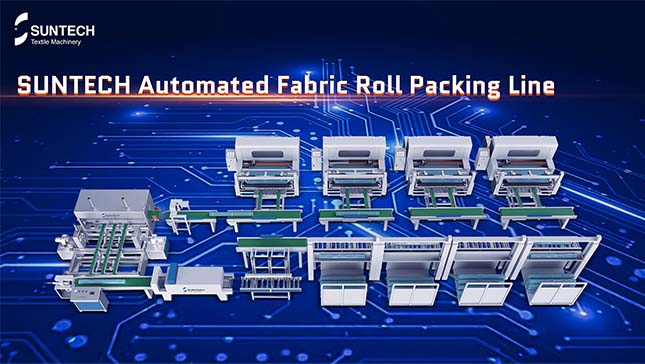The textile industry plays a crucial role in producing fabrics, which are then transformed into exquisite garments. These clothes serve multiple purposes such as providing warmth, conveying visual aesthetics, and adorning the wearer. Ultimately, the objective of textiles is to package and present beauty. As a result, the textile industry itself relies on packaging to ensure its products are protected.
To achieve organized packaging, textile manufacturers employ automatic packaging machine. These machines facilitate the systematic packaging of textile fabrics, allowing for smooth transition to subsequent production processes without any disruptions caused by disarray or handling difficulties. In certain factories, fabric rolls undergo critical stages like inspection and packaging before being transported to the next location for garment production.

Packaging the fabric rolls serves two important purposes: enabling efficient transportation and minimizing the risk of damage during transit. By securely packaging the rolls, they can be transported more effectively, saving time and resources. Additionally, proper packaging safeguards the fabric from potential harm, ensuring it arrives in optimal condition for garment manufacturing.
The fabric inspection and packaging line combines the processes of fabric inspection and packaging, enabling various types of fabrics, such as cotton, wool, linen, silk, and other materials, to undergo fast and accurate detection. Its basic components include fabric unwinding, tensioning, and rewinding devices; fabric inspection table, light source, and illumination; marking devices, and it integrates packaging machinery to achieve the integration of fabric inspection and packaging, saving time and effort, and greatly improving production efficiency.
The fabric inspection and packaging line can achieve multiple functions and gradually complete the processes of fabric inspection and packaging. It provides an ideal hardware environment for fabric inspection, continuously unwinds the fabric in sections, provides sufficient light sources, and allows the operators to visually inspect and identify fabric defects, color differences, and then proceed with measuring, winding, and finishing. Additionally, it is equipped with a computer-supported quality control system that assists in printing and outputting fabric inspection results, eliminating the need for manual record-keeping.
The fabric inspection and packaging line is constructed to be simple yet flexible and efficient. The speed can be adjusted according to specific needs using a speed controller. The fabric is easy to load, and the operation buttons allow for flexible control and switching. It operates stably with low failure rate and reliable accessories. It is highly practical and provides a good user experience.
If a machine malfunction occurs, the following steps should be taken to diagnose and repair it:
l If fabric gets stuck during inspection, it is usually not related to the intelligent fabric inspection machine itself but likely caused by uneven fabric placement. The operator simply needs to adjust the fabric guides correctly to ensure they are parallel to each other.
l If there is resistance when the fabric is being wound on the fabric guide roller, it may be due to the accumulation of dust, grease, or other debris in the transmission area of the intelligent fabric inspection machine. Component wear and looseness can also contribute to this issue, highlighting the importance of regular maintenance to prevent such problems.
l If the machine generates significant noise during operation, common causes include loose components, inadequate lubrication, or excessive distance between the transmission shafts, causing instability in the intelligent fabric inspection machine. The solution is straightforward: tighten the components and add lubricating oil as needed.
l If the brightness of the glass plate is low, it can affect the detection capabilities of the intelligent fabric inspection machine. Insufficient brightness is often caused by dust or fabric debris on the light source and glass plate, or the diminished brightness of the light tubes. Cleaning the dust, stabilizing the voltage, and replacing the light tubes will restore the brightness of the glass plate.
SUNTECH automatic packaging machine is a marvel of fully automated design, intended for seamless, vacuum-sealed packaging of fabric rolls. With a staggering capacity of 3360 rolls per shift, this machine effortlessly streamlines labor-intensive packaging tasks while offering a range of features such as smart sorting, vacuum packing, labeling, and ERP connectivity. By employing this state-of-the-art technology, you can greatly reduce your reliance on manual labor and enjoy the benefits of heightened productivity and unparalleled efficiency.




